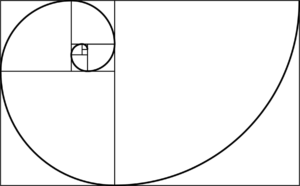Have the roles of Product Manager (ProMa), Product Owner, Technical ProMa and other such variants of Product roles confused you? If you want to understand a bit more about how one is different from the other, then read on!
A. Product Manager Roles Based on Expertise
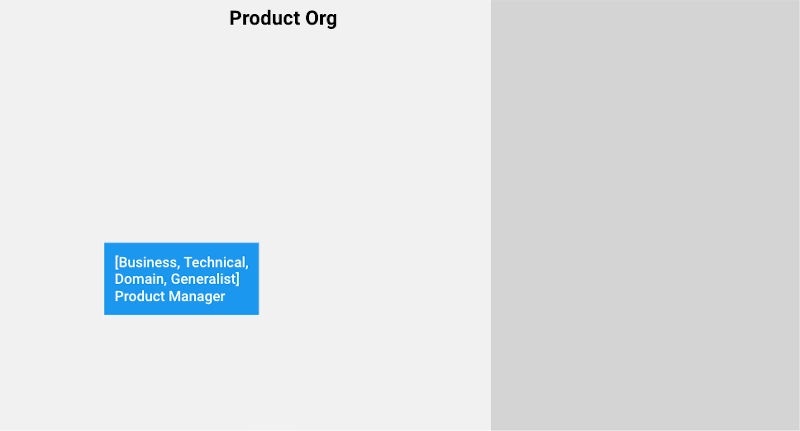
Based on their background and key strength, there are four types of Product Managers:
1. Domain Product Managers
They have deep knowledge about the domain the product is serving. This is very common in Product org building products for Travel, Hospitality, Retail or E-Commerce sectors.
Consider this brief JD I recently got from a media org:
The Sr. Product Manager is an expert in Account & User Management, focused on ensuring customers can create and manage accounts, profiles and devices in a secure, useful and intuitive manner. Having a keen eye for the identification and prevention of customer friction points is vital to the success of the candidate. The ideal candidate has strong domain expertise in subscription Direct-to-Consumer businesses and has experience in working at large scale. Experience in video streaming services is desirable.
2. Business Product Managers
They have a deep understanding of the business of the Product org. This includes expertise in relevant Business Models, sales processes and how the P&L of the product is being managed.
Consider this from a JD of a large IT manufacturing org:
- Serve as an evangelist for Infrastructure Services Portfolio, presenting to internal teams, and external partners and customers.
- Drive end to end product management execution from offering concept phase to plan, development, worldwide launch, maintenance and EOL
- Collaborate with geo Services Marketing and WW Marketing teams to generate internal and external product adoption and growth momentum.
- Develop messaging/value proposition for sales and customer enablement
- Create product disclosures, marketing content, training materials, and competitive analysis to support successful WW Services offering launch
- Manage existing offerings, establish and review schedules, facilitate meetings and ensure execution of programs/projects
- Effectively communicate status of projects and objectives to Services leadership
- Engage in the WW management and execution of cross-functional projects through the Offering Development Team (ODT) and Portfolio Investment Development Team (PIDT).
- Present strategic business cases, product positioning, and value proposition
- Deliver the marketing assets, training and enablement presentations, launch planning, and other deliverables.
- Provide product communications to worldwide geographies’ teams as well as jointly planning Go-To-Market to drive sales momentum
3. Technical Product Managers
They have deep knowledge of the technology of the product’s ecosystem. This is common when the product is used by technologists or highly skilled developers.
Consider this JD of an innovation team in a data-rich e-commerce org:
- Collaborate with multiple business units and product teams to define and prioritize the product roadmap for Computer Vision (CV) and Natural Language Understanding (NLU) platforms
- Work with DS leadership team to drive the research priorities in Vision and NLU products
- Work with the DS team to define the data requirements for our AI products and work with our internal partners to fulfill the same
- Understand and appreciate the current State-of-the-art in Computer Vision and NLU technology and create robust internal benchmarks for the same
- Work with one of the best data science and engineering teams to build high-quality models in NLU/CV and map it to the needs of different product and business requirements
- Write clear and effective product requirements banking on technical abilities with experience working on AI-based products
- Drive the platform products to successful adoption in various consumer-facing products
4. Generalist Product Managers
They have deep knowledge of the tools and techniques of product management. They can help build any product across any domain based on any business process. Their key strength is the ability to ramp up fast to gain sufficient knowledge of the domain and technology. Such roles are common in startups, scaleups and SME org.
Consider this JD from Google:
At Google, we put our users first. The world is always changing so we need Product Managers who are continuously adapting and excited to work on products that affect millions of people every day.
In this role, you will work cross-functionally to guide products from conception to launch by connecting the technical and business worlds. You can break down complex problems into steps that drive product development at Google speed.
One of the many reasons Google consistently brings innovative, world-changing products to market is because of the collaborative work we do in Product Management. Our team works closely with creative and prolific engineers, designers, marketers, etc. to help design and develop technologies that improve access to the world’s information. We’re responsible for guiding products throughout the execution cycle, focusing specifically on analyzing, positioning, packaging, promoting, and tailoring our solutions to our users.
Google aims to build products that organize the world’s information and make it universally accessible to our users. As a Product Manager at Google, you could be working on new technologies, platforms, consumer-facing products, and/or enterprise systems. The end goal will be to match you with the team that best aligns with your interests, experience, and where you will have the most impact.
B. Product Manager viz-a-viz Product Development
1. Product Owner
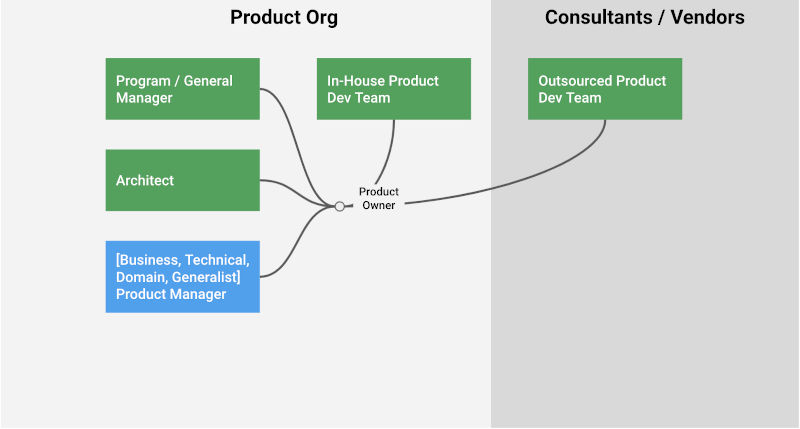
Among other tasks, one key task for a Product Manager is interacting with the software development team that is building the product. In the modern software development process, this role is often described as that of a Product Owner.
Consider this definition of a Product Owner from scrumguides.org:
The Product Owner is accountable for maximizing the value of the product resulting from the work of the Scrum Team. How this is done may vary widely across organizations, Scrum Teams, and individuals.
The Product Owner is also accountable for effective Product Backlog management, which includes:
- Developing and explicitly communicating the Product Goal;
- Creating and clearly communicating Product Backlog items;
- Ordering Product Backlog items; and,
- Ensuring that the Product Backlog is transparent, visible and understood.
The Product Owner may do the above work or may delegate the responsibility to others. Regardless, the Product Owner remains accountable.
For Product Owners to succeed, the entire organization must respect their decisions. These decisions are visible in the content and ordering of the Product Backlog, and through the inspectable Increment at the Sprint Review.
The Product Owner is one person, not a committee. The Product Owner may represent the needs of many stakeholders in the Product Backlog. Those wanting to change the Product Backlog can do so by trying to convince the Product Owner.
While this role is expected to be played by a Product Manager, it is common when this is played by someone else.
In my experience, I have come across the following playing the role of a Product Owner:
- Product Manager of the Product
- Chief Architect of the Product
- General Manager responsible for the P&L of the product line (and also owned support, marketing and other helper functions)
- Program Manager running the program on behalf of a General Manager
C. Product Manager Roles Based on Responsibilities
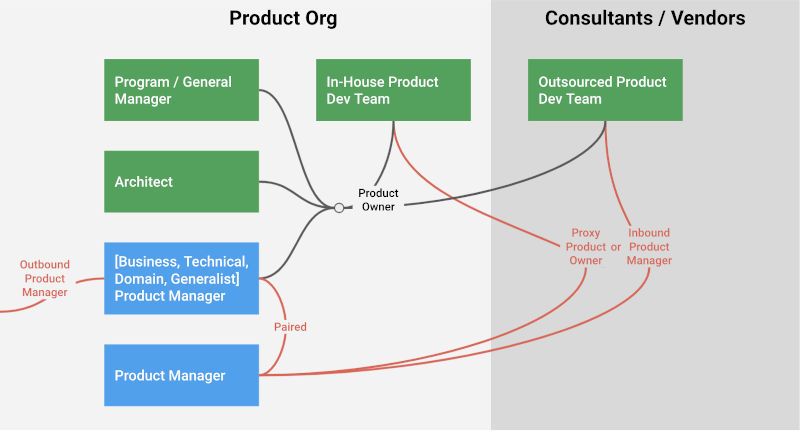
Often, another Product Manager is hired to pair with a Product Manager. Product Orgs may do this for the following reasons:
- Product Manager is a Domain/Technical/Business ProMa and needs help with best practices various tools & techniques, or
- Development of the product is in full swing and being executed by multiple teams and the Product Manager is unable to support them
1. Outbound Product Manager and Inbound Product Manager
Often the division of responsibility is around interactions with the product development teams.
Inbound Product Manager interacts with the software development team that is building the product. That includes answering any questions they may have and ensure that the vision, strategy and market feedback is passed on to the development teams.
Outbound Product Manager relies on the Inbound Product Manager to own the relationship with the software development team that is building the product. This allows them to focus on all other aspects of the product like Market Research, Competition Analysis, Business Model, Revenue, Cost, Sales, Marketing, Operations, Compliance, Support and manage the dynamics between Business Leadership and product teams.
2. Proxy Product Owner
The division of responsibilities can exceed just the focus on the interactions with the product development team. In such cases, the Proxy Product Owner ends up with additional responsibilities.
D. Product Manager Roles Based on Employee
There are two kinds of Product Management professionals today:
- Those who work for a Product org, and
- Those who work for a Services or Consulting org
Consultant Product Manager
Often Product Orgs take the help of services org or software consultancy to help them with build the whole product or a key part of it.
Typically, the team from the vendor (a common term for hired services org or software consultancy) side used to be deliver-oriented. Such a team tends to be composed of Developers, QA and BA. Nowadays, a Product Manager has also joined the mix.
There are two ways vendor’s Product Management professionals are used by the Product Orgs:
1. Staffed as a full Product Manager
Here the vendor helps the Product Org with staff augmentation. Product Orgs usually do this for the following reasons:
- to accelerate a Product Manager joining the team as hiring the right fit may take time,
- have access to highly skill Product Managers to set up various tools and processes for as long as needed, or
- to control the cost due to additional staff
They interact with the software development team that is building the product in the capacity of a Product Owner.
2. Staffed as a pair with the existing Product Manager
Here the Product Manager will end typically as an Inbound Product Manager or a Proxy Product Manager.
Summary Chart
The following is a pictorial representation of the above relationships:
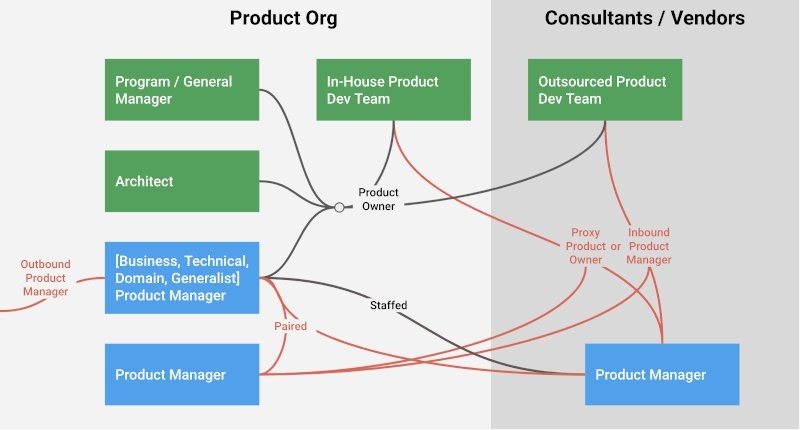
If you want an editable version of the diagram above, you can download the Google Slides version here: https://bit.ly/product-roles.
Summary Table
The following is a tabular representation of the above relationships:
| Product Role | Key Position of Strength | Role in Context of Product Development Team | Typically Found In |
|---|---|---|---|
| Generalist ProMa | Deep knowledge & experience of various tools and techniques of Product Management | Product Owner | Small and Medium Sized Enterprise |
| Business ProMa | Deep knowledge & experience of business methods the product is adopting | Product Owner | Large E-Commerce Enterprise |
| Domain ProMa | Deep knowledge & experience of the domain of the product | Product Owner | Large Retail Enterprise |
| Technical ProMa | Deep knowledge & experience of technology the product is enabling | Product Owner | Products for Technologists |
| Consultant ProMa |
|
|
|
| Program / General Manager | Ownership of Outcome and ability to drive budgets | Product Owner | Traditionally non-digital org |
| Architect | Deep technical knowledge & experience of technology the product is enabling | Product Owner | Org that are undergoing Digital Transformation |
Download as Presentation
Conclusion
What Product are you currently playing or aspire to play? Share your thoughts and opinion on LinkedIn or YouTube and tag me.

